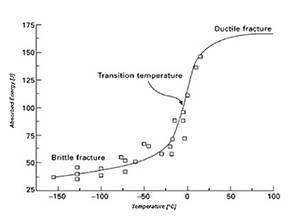The ductile to brittle transition temperature is a critical parameter to consider when measuring the impact strength of plastics, especially in automotive, aerospace, and other applications where safety is paramount. A drop weight impact testing machine analyzes a material's ductile to brittle transition according to the puncture test method or tensile impact test procedure. This blog looks at how the latest drop weight impact test technology can help optimize throughput, accuracy, and repeatability.
What is the ductile to brittle transition temperature?
The ductility of polymers depends on how much impact energy they can absorb before breaking, a property known as toughness. As the temperature decreases, a material becomes less ductile until it becomes brittle. This process is known as ductile to brittle transition. When a material reaches its brittle state, it loses most of its impact strength, meaning the chances of catastrophic failure increase exponentially.
In some applications, plastic materials must maintain their toughness and ductility even at low temperatures. For example, cars in winter or planes at high altitudes are routinely exposed to subzero conditions. Therefore, the materials used in these applications must remain ductile at low temperatures to ensure the safety of passengers in the event of an impact.
How to calculate ductile to brittle transition temperature
The puncture test method is the simplest way of measuring the ductile to brittle transition temperature. Standards ISO 6603-2 (Puncture Impact Behavior of Plastics) and ASTM D3763 (High-Speed Puncture Properties of Plastics) provide guidance on how to perform a puncture test on plastics. The process involves a striker hitting a disc or square-shaped specimen perpendicularly with a specific impact energy. Thanks to a specific load cell, it’s possible to determine the absorbed energy of the material during the impact event. This test often is a pre-requisite for materials used in automotive applications that must display advanced impact properties.
Another method to determine the ductile to brittle transition temperature is the tensile impact test. This test measures the force needed to break a specimen under a high-speed tensile load of up to 20 m/s. ISO 8256 is the standard to consider here.
Irrespective of the test method selected, measuring materials' ductile to brittle properties involves "conditioning" the samples to bring them to the desired temperature. This process can be challenging without an integrated conditioning apparatus.
Testing at low temperatures: what are the challenges?Typically, when conducting a puncture or tensile test, samples need to be cooled in an external cryostat before testing. This process has several disadvantages:
- Downtime – Every time a new test is performed, time is lost due to having to place the sample in a cryostat, waiting for it to cool, and then loading it onto the impact tester.
- Accuracy – By the time the sample is taken out of the cryostat and loaded onto the impact tester, its temperature may vary slightly, which can impact the accuracy of test results.
- Cost – Cryostats can be expensive and entail energy and maintenance costs.
- Footprint – Laboratories can be crowded places where floor space is limited. Cryostats can have significant footprint.
Sometimes, laboratories use homemade solutions to condition specimens already loaded onto the impact tester. For example, a pipe may be used to blow cold air from a cryostat directly on the sample. However, this method is energy-intensive and does not prevent potential temperature variations as the specimen is not in an enclosed chamber.
Luckily, there is another, more efficient way of testing at low temperatures.
Performing an accurate drop weight impact test at low temperaturesThe latest drop weight impact testing machines come with optional integrated thermostatic chambers containing the support fixture and the specimens. This way, you can condition samples quickly while they are already loaded, eliminating the downtime caused by transferring specimens from the cryostat to the tester.
With a temperature range between -70 °C and 150 °C, advanced drop weight machines can test plastics under most environmental conditions. By integrating the automatic feeding system, you can load up to 30 samples simultaneously, performing tests seamlessly. The latest software solutions enable you to set up a test in minutes, with the option of testing different samples at different temperatures without stopping every time. You could run up to 30 consecutive tests with temperature step variations as little as 2 °C.
Another significant benefit is that samples will always be at the desired temperature during testing, ensuring optimal accuracy and repeatability of results. You don’t have to worry about potential temperature variations that may occur while transferring a specimen from a cryostat to a tester.
Shall I use a drop weight impact tester or a pendulum?- Flexibility – Pendulums only allow you to run tensile tests, while drop weight testers are suitable for tensile and puncture tests, enabling greater flexibility;
- Energy and Speed – Pendulums only allow you to test samples at a fixed impact energy and impact speed, depending on the chosen hammer for the test, while drop weight impact testers can run tests across a wide and flexible energy and speed range;
- Temperature – Unlike drop weight impact testers, pendulums do not feature integrated thermostatic chambers.
Discover more on Instron’s Drop Weight Impact Testing Machines.
